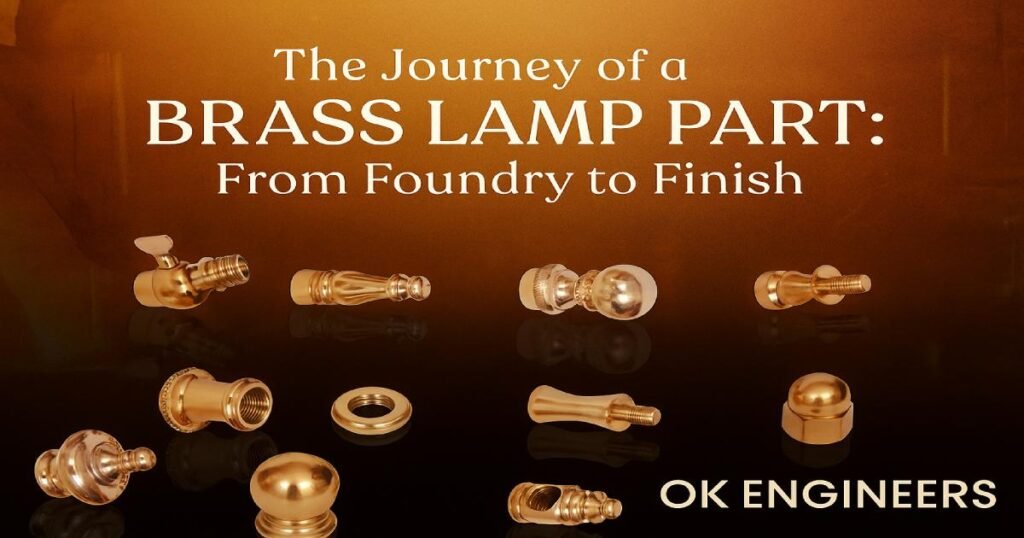Inroduction
The journey of a Brass lamp part—from its raw beginnings in the foundry to its polished, functional finish—follows a meticulous process involving material selection, precision casting, detailed machining, rigorous quality control, and eco-conscious finishing. Each stage combines modern innovation with time-honored craftsmanship, ensuring every brass lamp part is both beautiful and durable.
Understanding Brass Lamp Part Manufacturing in 2025
Brass, an alloy of copper and zinc, remains the gold standard for lamp parts due to its durability, aesthetic appeal, and resistance to corrosion. Today, advanced machinery, automation, and sustainability practices are transforming brass foundries worldwide.
Step-by-Step Journey of a Brass Lamp Part
1. Material Selection: The Brass Blend
- Raw Ingredients: Sourcing high-purity copper and zinc with strict checks for trace elements such as tin and lead ensures the lamp’s luster and longevity.
- Sustainability: Many foundries now use recycled metal, supporting eco-friendly goals and reducing energy consumption.
2. Melting & Alloying
- High Precision: Metals are melted at temperatures up to 940°C (1,720°F) in advanced furnaces. Automated sensors monitor the process, ensuring the perfect blend and minimizing impurities.
- Uniformity: Cutting-edge mixing techniques guarantee consistent alloy properties in every batch.
3. Casting the Brass
- Mold Creation: CAD/CAM software designs intricate Lamp parts, and molds are 3D-printed for complex or custom shapes.
- Casting: Molten brass is poured into these molds. Modern automation ensures ideal pouring speed and temperature, reducing air bubbles and improving surface finish.
- Initial Quality Check: Each casting undergoes visual and dimensional inspections, with any defects recycled or refined.
4. Machining & Shaping
- CNC Machining: Automated lathes and mills precisely cut, drill, and finish each part to specified tolerances. Computer-controlled systems ensure replication accuracy and allow customization for each lamp design.
- Surface Refinement: Shot blasting removes rough spots, while fine grinding readies the piece for final polishing.
5. Surface Finishing
- Polishing: Multiple-stage buffing brings out the iconic golden shine of brass. Some parts may undergo additional electroplating or receive specialized coatings for enhanced durability and resistance to tarnish.
- Eco-Conscious Finishes: Recent advances include the use of water-based and low-VOC finishes, aligning with global sustainability trends.
6. Assembly & Final Inspection
- Assembly: Skilled technicians fit together standardized and custom components, assembling fixtures with both functional and decorative elements.
- Quality Control: Automated scanners and human inspectors conduct rigorous checks for mechanical integrity, finish quality, and dimensional accuracy—backed by advanced spectroscopy, chemical analysis, and non-destructive testing.
Key Process Steps and Modern Innovations
| Step | Classic Method | Latest Innovations (2024-2025) |
| Alloying | Manual melting, mixing | Sensor-driven automated crucibles |
| Molding | Hand-carved molds | CAD/CAM, 3D-printed molds |
| Machining | Manual lathes | CNC & robotics for consistency |
| Finishing | Abrasive polishing | Eco coatings, ion plating |
| Quality Assurance | Visual/manual checks | Automated, AI-enhanced inspection |
Industry Trends and Data
- 2025 Market Growth: The global brass market is projected to reach $21.08 billion by 2033, driven by increased demand in renewable energy, electronics, and smart devices.
- Customization on the Rise: Additive manufacturing is enabling unique, complex lamp designs at scale while minimizing material waste.
- Sustainability Focus: Foundries are actively reducing emissions, using recycled material, and developing energy-efficient production lines—key for compliance and consumer trust.
Actionable Checklist: From Foundry to Finish
- Source high-purity or recycled copper and zinc
- Alloy using sensor-equipped, energy-efficient furnaces
- Utilize CAD/3D-printed molds for casting
- Embrace CNC machining for precision
- Apply eco-conscious finishing products
- Conduct rigorous, automated quality testing
- Document processes for traceability and compliance
Looking to source precision-crafted Brass lamp parts or need expert help bringing your lighting designs to life? Visit okengineers or contact our team of specialists to discuss your project requirements and get a custom quote today!
(FAQ)
- How is brass ensured to be of high quality for lamp parts?
Manufacturers employ advanced spectroscopy and chemical analysis to verify alloy composition, combined with visual and dimensional.
- Why is brass still a preferred metal for lamps in 2025?
Brass offers outstanding conductivity, corrosion resistance, and visual appeal, while being easy to shape for artistic or functional lamp designs.
- Are modern brass lamp parts eco-friendly?
Yes. Eco-friendly practices—such as recycling, emissions reduction, and water-based coatings—are now mainstream in responsible production facilities.
- How do foundries ensure consistency in every lamp part?
Automated processes control temperature, mixing, casting speed, and inspection routines, reducing human error and defect rates
Follow Us On – Facebook, Instagram
You May Also Like: Brass Terminal Bars for Earthing , 2025’s Top Brass Lamp Parts Manufacturers



